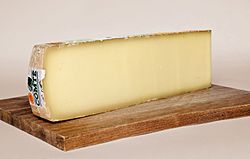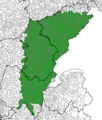Comté cheese facts for kids
Quick facts for kids Comté |
|
|---|---|
 |
|
| Country of origin | France |
| Region | Franche-Comté |
| Source of milk | Cows |
| Pasteurised | No |
| Texture | semi-hard |
| Aging time | 4–36 months |
| Certification | French AOC 1958 |
| Named after | Lua error in Module:Wikidata at line 70: attempt to index field 'wikibase' (a nil value). |
Comté (also known as Gruyère de Comté) is a famous French cheese. It is made from fresh, unpasteurized cow's milk in the Franche-Comté region of eastern France. This area is close to Switzerland and shares some of its food traditions.
Comté is one of the most popular French cheeses with a special quality label called AOC. This label means the cheese is made in a specific way in a certain place. About 66,500 tonnes of Comté are made each year, making it the most produced AOC cheese in France! It's known as a "Swiss-type" or "Alpine" cheese because of its style.
Each Comté cheese comes in a large, round shape. These "wheels" are usually between 40 cm (about 16 inches) and 70 cm (about 28 inches) wide. They are around 10 cm (about 4 inches) tall. Each wheel can weigh up to 50 kg (about 110 pounds)! The outside rind is often a dusty brown. Inside, the cheese is a pale, creamy yellow. Comté has a firm but flexible texture and a mild, slightly sweet taste.
Contents
How Comté Cheese is Made
Making Comté cheese is a careful process that starts right after the cows are milked.
From Milk to Curds
Fresh milk from the farm is poured into large copper pots. It's gently warmed up. Each big cheese wheel needs a lot of milk – about 600 liters (around 158 US gallons)! Then, a special ingredient called Rennet is added. This makes the milk thicken and separate into solid bits, called curds, and a watery liquid called whey.
The curds are then cut into tiny pieces, about the size of rice grains. These small curds are stirred and heated again for about 30 minutes.
Shaping and Pressing
Next, the warm curds are put into special moulds. The moulds help press out the extra whey, shaping the cheese. After several hours, the cheese is taken out of its mould.
Aging the Cheese
The cheese wheels are then moved to special cellars to mature. They stay at the dairy for a few weeks, and then they are moved to other places for several months. This aging process gives Comté its unique flavor and texture.
Special Rules for Comté
Comté cheese has been protected by AOC rules since 1958. These rules make sure that every Comté cheese is made to a very high standard. Here are some of the main rules:
- Cow Breeds: Only milk from specific types of cows, like Montbéliarde or French Simmental, can be used.
- Happy Cows: There can't be too many cows on the pasture. This ensures they have enough space to graze.
- Natural Food: Cows must eat fresh, natural grass and plants. They are not allowed to eat certain types of preserved feed.
- Fresh Milk: The milk must be taken to the cheese-making place right after milking.
- Quick Processing: The milk must be processed quickly after milking, depending on how it's stored.
- Raw Milk: The milk must be used raw. It can only be heated once during the cheese-making process, up to 56°C (133°F).
- Salting: Salt can only be put directly on the outside of the cheese.
- Labeling: Each cheese wheel gets a special label with its production date. It must age for at least four months.
- No Grated Comté: For many years (1979-2007), you couldn't buy grated Comté cheese under the Comté name.
In 2005, the French government officially recognized 175 cheese producers and 188 "affineurs" (people who age the cheese) in France.
How Comté is Graded
Every Comté cheese wheel is checked by inspectors and given a score out of 20 points. They look at different things:
- Overall Look: Up to 1 point.
- Rind Quality: Up to 1.5 points.
- Inside Look: Up to 3.5 points.
- Texture: Up to 5 points.
- Taste: Up to 9 points (this is the most important part!).
Cheeses that score 14 points or more are called "Comté Extra." They get a special green label with a bell logo. Cheeses that score between 12 and 14 points are simply called "Comté" and get a brown label. If a cheese scores very low on taste (1-2 points) or less than 12 points overall, it cannot be sold as Comté. Instead, it's used for other things.
The "Jury Terroir"
Comté cheese is famous for its "terroir." This means its unique taste comes from the specific place it's made, including the soil, climate, and traditions. Comté is made in about 160 small, village-based cheese factories called "fruitières." These are owned by local farmers who bring their milk there.
To make sure Comté always tastes great, there's a special group called the "jury terroir." This group is made up of trained volunteers, including people from the Comté cheese industry and the region. Every two months, they taste different Comté cheeses and talk about their flavors. They share their findings in a newsletter.
The "jury terroir" was started by a food scientist named Florence Bérodier. It helped people understand and appreciate the many different tastes of Comté cheese. Even though there are 160 different factories, the jury terroir helps everyone communicate about the cheese's quality and unique flavors. This has helped Comté become known and loved all over the world!
Images for kids
See also
 In Spanish: Comté para niños
In Spanish: Comté para niños



